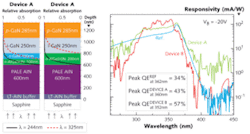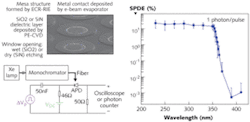CAN BAYRAM and MANIJEH RAZEGHI
Development of wide-bandgap III-nitride semiconductors has been a subject of intense focus since the 1990s, primarily driven by the quest for blue lasers and high-brightness light-emitting diodes (LEDs). In parallel, III-nitrides have been studied extensively for use in ultraviolet (UV) photodetectors because they offer intrinsic visible- or solar-blind detection, which would eliminate the need for expensive and efficiency-limiting optical filters to remove out-of-band visible or solar photons. Such detectors would be well suited for numerous applications in the defense, commercial, and scientific arenas, including covert space-to-space communications, early missile-threat detection, chemical and biological threat detection and spectroscopy, flame detection and monitoring, UV environmental monitoring, and UV astronomy.
Despite the advantages of III-nitride-based photodetectors, however, photomultiplier tubes (PMTs) still dominate in many of these applications. Photomultipliers can provide high sensitivity using internal electron-multiplication gain (typically ~106), and a degree of visible- or solar-blindness with careful selection of photocathode material. But PMTs are also bulky and fragile, and require large biases (typically 1000 V) to operate effectively. Therefore, a compact, highly sensitive semiconductor-based photodetector would be a welcome alternative.
In principle, it is possible to achieve this goal with III-nitrides by taking advantage of avalanche multiplication under high electric fields–typically 2.7 MV/cm. With proper design, this can correspond to an external reverse bias of less than 100 V.1
Back is better
Despite the relative ease of growing front-illuminated gallium nitride (GaN) APDs, back-illuminated GaN APDs have proved to be more advantageous.2 In a back-illuminated (p-doped) intrinsic (n-doped) (PIN) GaN structure, in which photons reach the n-type layer first, most holes are injected into the high-gain multiplication region (see Fig. 1, left). This enables higher gain and better overall performance because with GaN, near the critical field strength, the impact-ionization coefficient of the hole is higher than the impact-ionization coefficient of the electron. In addition, the integration of APD arrays with read-out electronics is easier in a back-illumination scheme.
Besides higher gain, a back-illuminated APD generates less noise. Because ionization events are initiated only by holes, statistical variation in the avalanche process is reduced as the holes traverse the multiplication region. In a normal back-illuminated device structure, the absorption of photons is not limited to the n-type layer, and a portion of the photons is absorbed in the multiplication region itself. This means that gain is not necessarily hole-initiated since electrons can be generated by photons absorbed in the multiplication region. Electron contribution to gain results in lower gain and higher noise than should otherwise be possible.
One way to overcome this limitation is to insert a thin n-type separation region between the absorption and multiplication regions to create a separate absorption and multiplication APD (SAM-APD) structure. The use of SAM regions is a common approach to reducing multiplication noise and enhancing gain through impact-ionization engineering. Gallium nitride avalanche photodiodes designed this way allow for nearly pure injection of holes into the multiplication region, and benefit from the higher ionization coefficient by offering lower noise performance and higher gain (see Fig. 1, right).3
More measures for performance
In addition to impact-ionization engineering, carefully controlling material quality and doping can also enable better performance.
The breakdown voltage of APDs is largely determined by electric-field buildup in the device and the voltage at which the critical electric field is reached. Because the dark current tends to increase with voltage, reducing the breakdown voltage can be advantageous for achieving higher gains. For a given multiplication width, the primary limitation on the electric-field buildup is the low carrier concentration of the p-GaN layer.
The p-GaN quality is low for two reasons. First is a tradeoff in growth conditions because conditions that maximize magnesium (Mg) incorporation can degrade GaN quality. Second, the high activation energy of Mg requires that it be incorporated into the lattice at a level almost 100 times higher than the desired carrier concentration–which leads to a disruption of the GaN lattice.
To overcome this and realize a high-quality p-GaN, we have investigated the use of a novel δ-doping technique.4 Compared to regular bulk p-type doping, δ-doped p-GaN layers have demonstrated higher structural and electrical quality. By incorporating δ-doped p-GaN into a SAM-APD structure, we have produced devices with superior performance.Single-photon detection
Many applications can benefit from–and some actually require–UV detectors with single-photon detection capabilities. In APDs it is possible to realize single-photon detection by using Geiger-mode operation, which entails operating the APDs well above the breakdown voltage and using pulse-quenching circuitry. When the electric field is high enough that a single charge carrier injected into the multiplication layer triggers a self-sustained avalanche, the current will flow until the avalanche is externally quenched. By developing a back-illuminated Geiger-mode APD, we have realized Geiger-mode APDs with a SPDE of 23% and a dark-count rate below 10 kHz (our measurement limit).6
We measured the pulse detection efficiency of a fabricated GaN APD at different photon fluxes (photons/pulse) by varying the incident optical power. At high photon fluxes, the pulse detection efficiency was 100% and approached the SPDE value as we reduced the number of photons per pulse. In the 625 µm2 area devices, we reached SPDE of 20% between 350 and 230 nm–which includes the so-called solar-blind range. Below the bandgap, we measured a sharp cutoff and a high visible light-rejection ratio (more than 104; see Fig. 4).Implications
Ultraviolet detection is important–many biological agents, including anthrax, luminesce in UV. Scattering of short-wavelength light in the atmosphere enables non-line-of-sight secure communications in rugged terrains, whereas strong reflection/absorption of UV at ionosphere promises secure space-to-space communications. Our highest performing UV GaN APDs demonstrated ruggedness and efficiency with gains of 53,000 and EQE of 57%. As the performance of GaN APDs is further enhanced, applications such as UV single-photon detection can emerge.
Realization of the world’s first UV single-photon detectors (SPDs) with efficiencies as high as 20% could enable quantum computing and data encryption in the near future. Compared with PMTs or superconducting single-photon detectors, the use of Geiger-mode APDs presents key advantages such as lower operation voltages, much reduced sizes, and no need for cooling to very low temperatures. This in turn may enable the fabrication of more-compact, lower power, and all-solid-state APD/CMOS integrated arrays.
ACKNOWLEDGMENTS
The authors acknowledge valuable collaboration with J. L. Pau of Universidad Autonoma de Madrid; R. McClintock at Center for Quantum Devices of EECS Department and Prof. M. P. Ulmer at Department of Physics and Astronomy, both at Northwestern University; D. Silversmith of the Air Force Office of Scientific Research; and the collaboration of Dr. Ferechteh H. Hosseini and her group at Nanovation (France).
REFERENCES
- C. Bayram et al, Appl. Phys. Lett. 92, p. 241103 (2008).
- R. McClintock et al, Appl. Phys. Lett. 90, p. 1411121 (2007)
- J. L. Pau et al, Appl. Phys. Lett. 92, p. 101120 (2008).
- C. Bayram et al, J. of Appl. Phys. 104, p. 083512 (2008).
- C. Bayram et al, Appl. Phys. Lett. 93, p. 211107 (2008).
- J. L. Pau et al, Appl. Phys. Lett. 91, p. 041104 (2007).
Can Bayram is a research assistant and Ph.D. candidate working with Manijeh Razeghi, Walter P. Murphy Professor of Electrical Engineering and Computer Science and Director of the Center for Quantum Devices, Northwestern University, Evanston, IL; e-mail: [email protected]; http://cqd.eecs.northwestern.edu.



